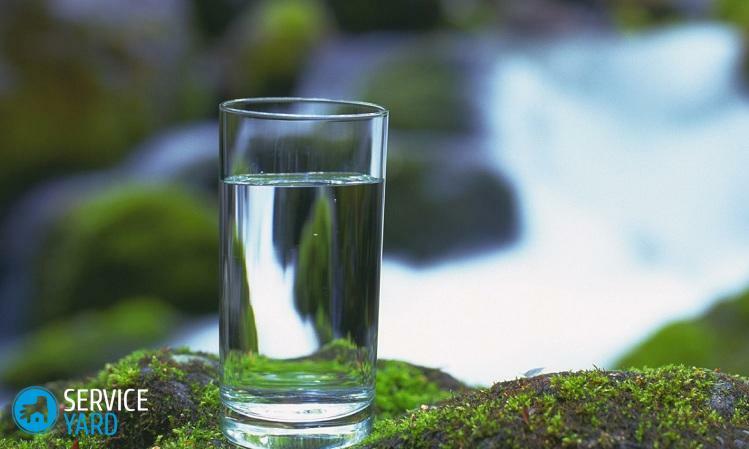
- Making filters for an apartment
- How to make a filter for a well?
- Making filters for wells
Any person quickly gets used to everything good, therefore it is rather difficult for members of modern society to do without all the benefits of civilization. Most residents of urban apartments prefer to clean potable water with the help of special filters, which are installed directly under the sink. Unfortunately, residents of private houses and suburban areas are less lucky, because they do not have the opportunity to connect to the central water supply system and enjoy all the benefits of the cleaning facilities. In principle, it is possible to purchase an ordinary filter-jug for water purification. But what to do if it is not enough and you need to clean the water not only for drinking, but also for household needs. Today we will get acquainted with the most popular ways of how to make water filters for yourself in the city apartment and in the private sector.
to the contents ↑Manufacture of filters for the apartment
There are two options how to make a filter for water at home, which is very popular among urban residents. Actually, we will discuss them further.
How to remake an old water filter?
Perhaps once you have already used a special filter, but the cartridge responsible for cleaning the water has already become unusable and is unable to perform its function. Do not rush to buy a new one, because it can be restored.
To do this, you will need these materials:
- Case from the old filter element.
- Activated or charcoal.
- Wadded disc.
Such self-made water filters for water are made by their own hands very simply:
- Carefully cut out the top part, set aside, since you will not need it any more. Leave only the upper clamping ring.
- Remove the spent contents of the filter, and rinse the body thoroughly with water.
- Divide the cotton wool in half, put one half on the bottom of the case.
- Fill the chopped charcoal casing.
- Cover it with the second half of the cotton wool, fix it with a ring.
Important! There are such models of cartridges, in which the clamping ring in the case is not fixed. In this case, it can be fixed with a sealant, only a couple of drops will suffice, the main thing is that it should be non-toxic and waterproof.

How to make a filter from improvised materials?
To make a home-made water filter option, you will need:
- Empty plastic bottle with a lid, which is tightly screwed. A piece of cotton fabric.
- Charcoal.
Now, step by step, we will look at how to make a water filter by our own hands from a bottle:
- At the first stage, charcoal must be activated:
- It must first be crushed in a croup so that the diameter of the particles is not less than 4-6 mm. The coal needs so much to be enough to fill the bottle by two thirds.
- Then pour it into a container of water, bring to a boil and let simmer for another five minutes.
- After this, drain the water with a metal sieve or colander. But notice that the water should be still hot.
- Allow the charcoal to cool completely.
- In the second step, make a few holes in the lid of the bottle with a diameter of 3-3.5 mm.
- In the third stage, it is necessary to cut the bottom from the bottle.
- In the fourth stage, put cotton cloth in the neck of the bottle.
- The fifth stage is the activation of activated carbon in the tank.
Important! Such a filter will last you a long time. And when you feel that the water has changed again to taste, then just rinse the used coal, re-boil it, replace the cloth and continue to use it calmly.
to the contents ↑How to make a filter for the well?
Living in a private sector or at a dacha, people also want to have some kind of device for filtering water, even if it comes from a clean well. Why do this? The fact is that pesticides and nitrates, which are used during the processing of the garden and garden, are capable of seeping into the ground and falling with groundwater directly into the water of the wells. There is a way out - you can make water filters with your hands from natural materials and install it on the bottom.
But first you need to decide which bottom is in your well:
- If it is clay with beating springs, then it is better to install a coarse filtration system in water intake structures. Bottom accommodation in such a situation can only harm and block the outlet of spring water.
- If the bottom consists of a soft clay and is washed away with water, then it is advisable to lay a layer of large crushed stone 15-20 cm thick.
- But the sandy bottom, through which water freely percolates, needs just a bottom filter. If this is not done, then when the buckets hit the bottom or water, the sand will blur and create a muddy residue.
Important! Pumps here are inappropriate, because they will be strongly clogged with sand and break.
- If the bottom is covered with sand, which is highly saturated with groundwater, then in addition to the bottom filter, you can also install a protective bottom with a shield from the tree from the erosion.
What materials can I use for the bottom filter?
In your discretion, you can use such natural materials:
- Quartz coarse-grained sand. It consists of grains up to 1 mm in size, so it must be washed before laying it in a well.
- Gravel. It is a loose porous sedimentary rock, with gravel grains ranging in size from a few millimeters to several centimeters.
- River shingle. These are roundish pebbles of different size and color.
- Crushed stone. These stones are extracted mechanically, so they may have irregular shapes and different sizes.
Important! To make a filter using gravel, it is better to use neutral minerals, for example, jadeite. Construction and granite gravel are not suitable for this.
- Zeolite. This mineral is most often used for water purification, because it persistently withstands the attacks of any microbes, bacteria and viruses.
- Shungite or petrified oil. Often it is used in alternative medicine, and it effectively purifies water from dioxides, radicals. It is a unique bactericidal agent.

Laying the bottom filter
If it is necessary to make a shield for the well, then it is better to make it from such tree species as oak or aspen. They are able to remain in the water for a long time. Construction of the structure is as follows:
- First you need to build a board from the boards, cut according to the dimensions of the well, drill holes in 1-1.5 mm, wrap with geotextiles and lower them to the bottom. On top of the shield lay a layer of large stone.
- Next, you need to determine the version of the filter to be installed, which can be direct or reverse. If the bottom of the well is covered with soft clay or a bottom shield from the buoys, then it is better to use a direct filter, that is, to make packing from the largest fractions to small ones. Each layer should have a thickness of 15-20 cm. It is recommended to make at least three layers: the first - will consist of rubble or stones 5-6 cm in size, the second - from shallow river pebbles, gravel or schungite, and the third - from washed river sand.
Important! Backward filters are used in wells with a sandy bottom, as they do not allow the grains to rise upwards and protect the bottom from large debris. Laying them occurs in reverse order, that is, first comes a small fraction, and then a large fraction.
- Then follows the installation directly, depending on the type of filter selected.
- In operation, devices are clogged with small particles of sand and clay, so you need to clean them every year. To do this, the sand is replaced completely, and the stones are simply removed and thoroughly washed under running water. The filter is placed back in the same sequence.
Production of filters for wells
In wells water is also cleaned with filters. Dacha owners and private house owners often use perforated perforated systems for this. Such devices are quite efficient and simple.
Before you make a water purification filter at home of this type, you need to prepare the following materials and tools:
- A plastic pipe made of environmentally friendly material or metal that is not rusted. Its length is determined depending on the depth of the well, but should not be more than 5 meters, and its diameter should be less than the diameter of the well.
- Fine-mesh stainless steel or brass mesh.
- Drill with a drill.
- A plug in the form of a wooden cork.
Step by step the manufacture of such a purification system looks like this:
- First measure the length of the settler. Depending on the depth of the well, it can be from 1 to 1.5 meters.
- Next, you need to drill holes at an angle of 35-60 degrees, directing them from the bottom up. They should be staggered, and the distance between the holes should not exceed 2 cm.
- Now you need to clean the pipe from the chips and wind the perforated zone with a grid. We fix it with rivets.
- Close the stopper plug with the sump from the sump side.
Important! The water that will pass through the holes and the grid will get rid of clay, silt and sand. And larger particles, accidentally trapped in a pipe, will settle in a sump. Such a filter will make the water in your garden and the private house transparent and clean, but that harmful substances will still remain in it. That is why it is recommended to boil it or run it through a charcoal filter.
Now you know how to make a water purification filter for both a city apartment and a private sector. The options for manufacturing cleaning devices described in this article will allow you to enjoy the use of crystal clear water without harmful impurities and debris.



